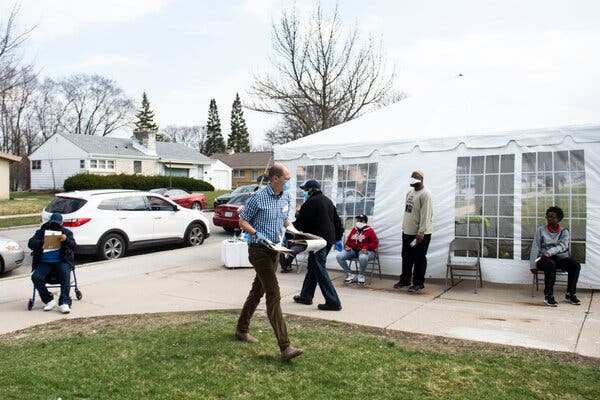Advertisement
President Trump has insisted that the Republican convention is moving ahead for August despite the coronavirus. But even he has expressed openness to a scaled-down event.

The money to pay for the Republican National Convention in Charlotte, N.C., is mostly raised, and contracts with hotels and local vendors are signed. The delegates are set to easily anoint a party nominee who fought tooth and nail for the title four years ago.
But instead of preparing to celebrate President Trump, White House and Republican officials are now quietly looking at the likelihood of a pared-down convention, with the coronavirus appearing increasingly likely to still pose a serious threat in late summer.
Publicly, officials have insisted they are moving full steam ahead with their plans for a traditional nominating convention in Charlotte, a major city in a swing state that Mr. Trump won in 2016. On Monday, the Republican National Committee sent its donors the official invitation to the convention, which stated that the event was proceeding apace and would be held from Aug. 24-27.
But behind the scenes, Republicans are looking at possible contingency plans, including limiting the number of people who descend on Charlotte to only delegates, and making alternate delegates stay home, according to interviews with a half-dozen Republicans close to the planning.
Mr. Trump, who was heavily involved in the staging of his last nominating convention, has even shown a new openness to participating in a scaled-down event. He has mused aloud to several aides about why the convention can’t simply be held in a hotel ballroom in Florida, given all of the health concerns and the fact that Florida is further along in reopening portions of the state.
But with expensive contracts signed and money raised, the event is unlikely to move from Charlotte — unless the Democratic mayor and governor there say it can’t be held.
On a call with reporters on Monday, Ronna McDaniel, the chairwoman of the Republican National Convention, said that a virtual convention — something the Democrats are discussing — wasn’t an option for the Republicans. R.N.C. officials cited party rules about an in-person convention that were set in 2016, which stated that “Republicans cannot change the rules until after the convention convenes,” meaning there must be an in-person convention this time.
But Ms. McDaniel appeared to leave open the possibility that the convention’s format and time frame could shift despite the printed invitations. “It’s quite a ways away, and there’s ample time for us to adjust, if necessary,” she said.
Ms. McDaniel and other Republicans have said that they have hired a medical expert and that they are consulting with the governor of North Carolina and the mayor of Charlotte, who have been focused on controlling the spread of the coronavirus. Local politicians in North Carolina, including Republicans, have expressed skepticism that the convention will be able to go forward as planned.
In an interview with MSNBC on Sunday, Mayor Vi Lyles of Charlotte hinted that there could be changes to an agreement that the city entered two years ago to host the convention, given the current circumstances.
“We’ve got vulnerable populations,” Ms. Lyles said, referring to people who are especially susceptible to the coronavirus. She followed that up with a tweet on Tuesday saying, “My #1 priority is the health and safety of Charlotteans and any decision or adaptions must be made in their interest and based in science and facts.”
A state official said the governor, Roy Cooper, had said it was too soon to make a decision, but added that officials were trying to work with national Republicans as the date draws closer.
Mr. Trump has made clear that he will fault Democrats if changes are made.
“I’m a traditionalist, but we’ll have to see, like everything else, but I think we’ll be in good shape by that time,” Mr. Trump told an interviewer with The Washington Examiner during a visit to Pennsylvania last week. “We have a great state, North Carolina, that’s been very, very good.”
But the president added: “Although, it’s got a Democrat governor, so we have to be a little bit careful. It’s got a Democrat governor, so we have to be a little bit careful with that, because they’re playing politics. They’re playing politics, as you know, by delaying the openings.”
The debate over how to handle the convention reflects the schism between the Trump administration’s response to the virus and how his critics — and the majority of public health experts — say it should be handled.
“The approach each party is taking to convention planning is becoming a microcosm of what the election is going to look like,” said Joe Solmonese, the chief executive of the Democratic National Convention. “While the Trump administration is ignoring the public health landscape, presuming things will miraculously improve in 13 weeks and moving forward with plans for a massive in-person convention, Democrats are acknowledging the severity of this pandemic that’s already killed over 90,000 people and taking proactive steps to prevent more people from getting sick.”
Mr. Trump, encouraged by conservative allies and worried about his re-election chances, has pushed for more aggressive reopenings across the country as the economic and job losses caused by the virus have reached staggering heights. Democrats have noted warnings from health experts in his own administration about relaxing restrictions too quickly.
For Mr. Trump, this year’s convention was set to be a marked departure from 2016, when he captured the nomination despite attempts to wrest it away from him, including at the convention in Ohio. There, delegates including Ginni Thomas, the conservative activist and wife of Justice Clarence Thomas, tried to stop him from becoming the nominee.
Those efforts failed. And four years later, the party is almost entirely in lock step with Mr. Trump.
But several Republicans have expressed concerns about how to pull off a large gathering as the pandemic continues, despite Mr. Trump’s desire to project a show of resurgence in the face of it.
Some senior Republicans recalled changes to the rules after the terrorist attacks of 2001. At the 2004 convention in New York, R.N.C. officials did not allow delegates to carry briefcases or handbags into Madison Square Garden. But they wondered how it was possible to protect against the asymptomatic spread of a virus. There was a recognition among party officials, Republicans said, that every day there was a new hurdle, and that they were hoping those health issues would simply be removed from their plates by August. But that is looking increasingly unlikely as experts warn that states’ moves to reopen could mean thousands of new deaths.
Some donors said that for the president to press his message that life is returning to normal before Election Day, the convention would need to be consistent with it.
“It won’t do for the president to hide. His base expects to see him on that stage,” said Dan Eberhart, a Republican donor, who repeated the Trump campaign’s line that former Vice President Joseph R. Biden Jr., the presumptive Democratic nominee, is “hiding.”
“People are ready to get back to normal. The president gets that,” Mr. Eberhart said. “If it’s pared down, it will show. It needs to be a big show to counter the narrative that we’re headed into a recession. It’s hope in the face of fear.”



